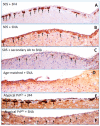Prion Strain-Specific Structure and Pathology: A View from the Perspective of Glycobiology
- PMID: 30567302
- PMCID: PMC6315442
- DOI: 10.3390/v10120723
Prion Strain-Specific Structure and Pathology: A View from the Perspective of Glycobiology
Abstract
Prion diseases display multiple disease phenotypes characterized by diverse clinical symptoms, different brain regions affected by the disease, distinct cell tropism and diverse PrPSc deposition patterns. The diversity of disease phenotypes within the same host is attributed to the ability of PrPC to acquire multiple, alternative, conformationally distinct, self-replicating PrPSc states referred to as prion strains or subtypes. Structural diversity of PrPSc strains has been well documented, yet the question of how different PrPSc structures elicit multiple disease phenotypes remains poorly understood. The current article reviews emerging evidence suggesting that carbohydrates in the form of sialylated N-linked glycans, which are a constitutive part of PrPSc, are important players in defining strain-specific structures and disease phenotypes. This article introduces a new hypothesis, according to which individual strain-specific PrPSc structures govern selection of PrPC sialoglycoforms that form strain-specific patterns of carbohydrate epitopes on PrPSc surface and contribute to defining the disease phenotype and outcomes.
Keywords: N-linked glycans; glycosylation; prion disease; prion strains; prions; sialic acid; sialylation.
Conflict of interest statement
The authors declare no conflict of interest.
Figures






References
Publication types
MeSH terms
Substances
Grants and funding
LinkOut - more resources
Full Text Sources
Research Materials

